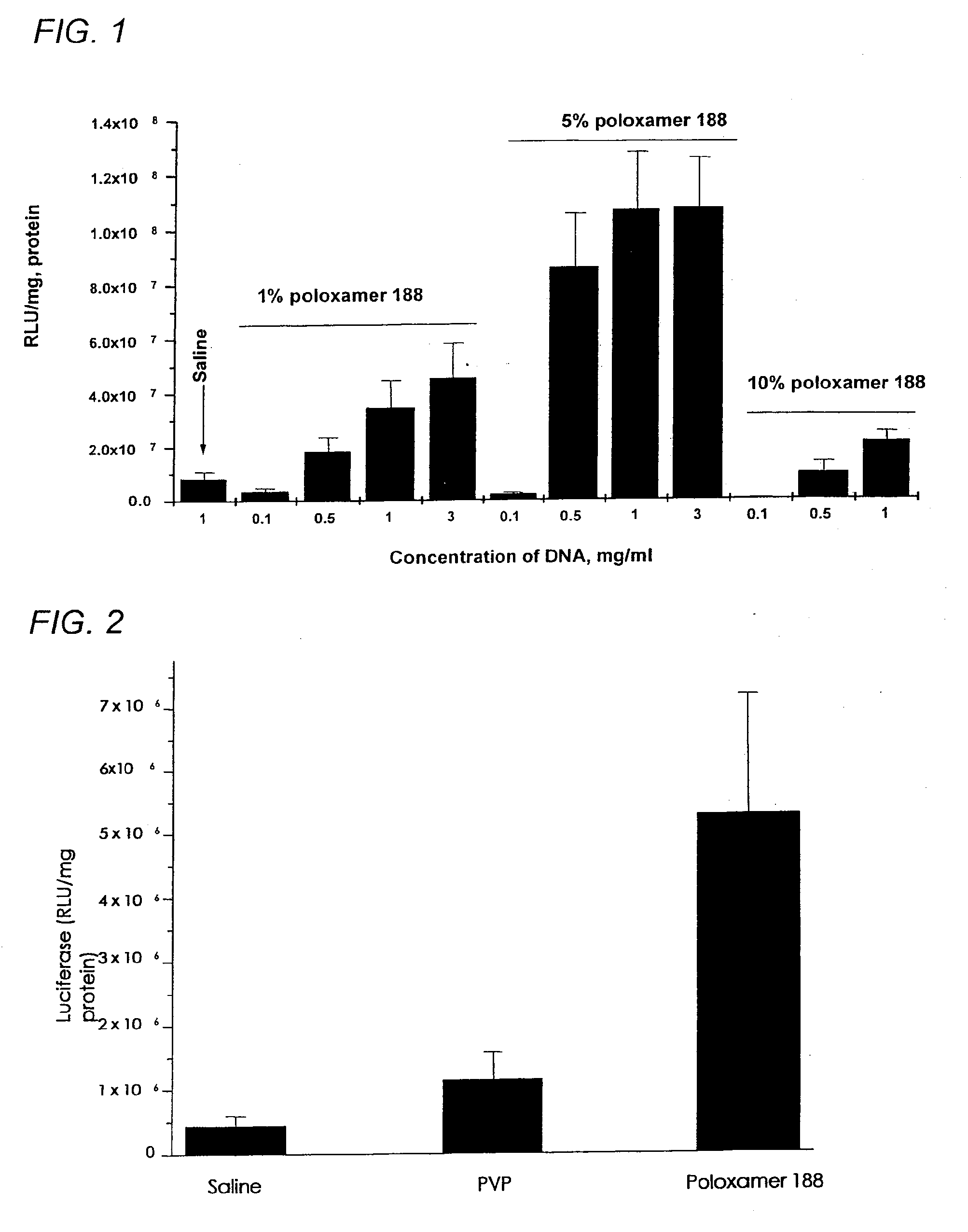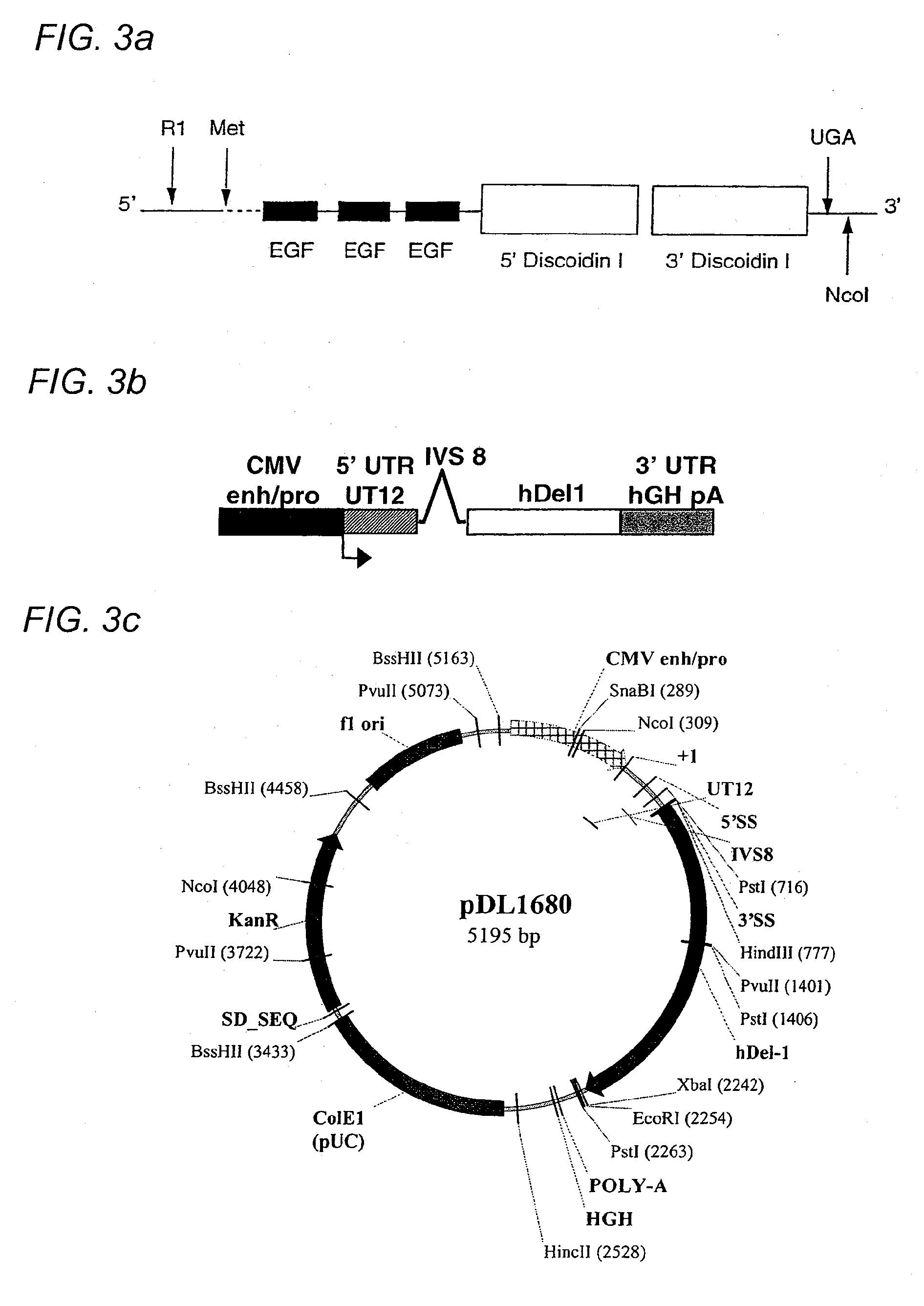Gene delivery formulations and methods for treatment of ischemic conditions
a technology of ischemic conditions and gene delivery formulations, applied in the direction of drug compositions, peptide/protein ingredients, cardiovascular disorders, etc., can solve the problems of cardiac ischemia, infarction, chest pain, etc., and achieve the effect of avoiding problems with toxicity and efficient delivery of angiogenic factors
- Summary
- Abstract
- Description
- Claims
- Application Information
AI Technical Summary
Benefits of technology
Problems solved by technology
Method used
Image
Examples
example 1
Formulation for Enhanced Plasmid Delivery to Skeletal Myofibers
[0105]Enhanced delivery of plasmid to muscle may be accomplished by formulation with PINC™ (Protective, Interactive, Non-Condensing) polymeric delivery systems. The PINC™ delivery system for Del-1 is comprised of a U.S.P. NF grade poloxamer 188 (Pluronic® F68). FIG. 1 shows the effect of plasmid and poloxamer 188 concentration on delivery of expression plasmid in murine skeletal muscle. Mice were injected im into the tibialis anterior muscles with 10 microliters plasmid / poloxamer 188 formulation containing plasmid and poloxamer at concentrations ranging from 0.1 to 3.0 mg / ml and 1 to 10% (w / v), respectively. Injected muscles were harvested 7-day post injection and assayed for luciferase expression. Data presented are the mean+ / −SEM for n=10 muscles / group. An optimized plasmid / poloxamer 188 formulation consisting of 1 mg / ml plasmid with 5% (w / v) poloxamer 188 yielded expression that was approximately one log higher than t...
example 2
Del-1 Expression Plasmid
[0108]A Del-1 expression system was developed incorporating the cytomegalovirus (CMV) promoter, a 5′ synthetic intron, the hDel-1 cDNA, and the 3′ polyadenylation signal and untranslated region from the human growth hormone gene (FIG. 3b). In addition to the expression plasmid encoding human Del-1, an analogous murine Del-1 expression plasmid has been constructed. The mDel-1 plasmid has been utilized in some preclinical murine studies. The Del-1 expression cassette shown in FIG. 3b is contained in a plasmid backbone containing the bacterial gene for kanamycin resistance (FIG. 3c), which allows for selective growth during plasmid production. Use of other expression backbones including for example alternative promoters, 5′ and 3′ untranslated regions, polyadenylation signals may be employed and are well known in the art. FIG. 12 depicts the nucleotide sequence for human Del-1 while FIG. 13 depicts the nucleotide sequence of human Del-1 expression plasmid pDL168...
example 3
Pharmacology of Del-1 Gene Medicine
[0109]Del-1 Western: The protein product from the Del-1 encoding vector was analyzed by performing a SDS-PAGE gel. The lyophilized muscle tissue was homogenized in 2 ml tubes containing 2.5 mm silica beads with lysis buffer at 10 microliters / mg wet weight, and the non-soluble material was centrifuged out. A NOVEX Tris-Glycine gel was ran with a high molecular weight marker (SIGMA #C3312), 50 nanograms of a peptide standard (PROGENITOR), or 50 micrograms total protein of unknown samples per lane. The gel was transferred to nitrocellulose membrane, and blocked for 1 hour in PBS / 0.1% Tween-20 / 5% dry milk / 4% BSA. The primary antibody was a rat anti-Del-1 monoclonal added at a dilution of 1:500 into blocking buffer over night. After thorough was washing in PBS / 0.1% Tween-20, an anti-rat HRP secondary antibody was added in PBS / 0.1% Tween-20 at 1:10,000 dilution. The membrane was incubated for 1 hour, then washed thoroughly and incubated in AMERSHAM ECL c...
PUM
| Property | Measurement | Unit |
|---|---|---|
| hydrophobic molecular weight | aaaaa | aaaaa |
| hydrophobic molecular weight | aaaaa | aaaaa |
| molecular weight | aaaaa | aaaaa |
Abstract
Description
Claims
Application Information
 Login to view more
Login to view more - R&D Engineer
- R&D Manager
- IP Professional
- Industry Leading Data Capabilities
- Powerful AI technology
- Patent DNA Extraction
Browse by: Latest US Patents, China's latest patents, Technical Efficacy Thesaurus, Application Domain, Technology Topic.
© 2024 PatSnap. All rights reserved.Legal|Privacy policy|Modern Slavery Act Transparency Statement|Sitemap



